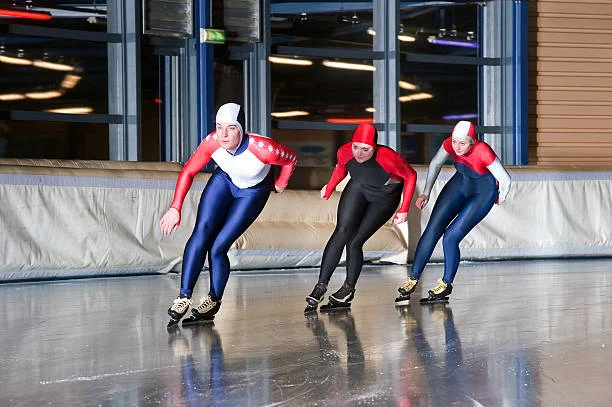Speed Skating Rules
Speed Skating Rules
In the realm of winter racing, Speed Skating emerges as a dynamic sport, where athletes engage in fierce competition on a circuit adorned with ice, skillfully maneuvering through the frigid expanse with the aid of skates. Three primary iterations of speed skating govern the icy domain: Long Track Speed Skating, Short Track Speed Skating, and Marathon Speed Skating. Within the Olympic lexicon, "Speed Skating" denotes the Long Track category, while the succinct moniker "Short Track" encapsulates its counterpart.
The genesis of Speed Skating can be traced back to the 19th Century, its exact origins shrouded in perpetual debate, but the inaugural competitive events unfolded in Norway during 1863.
Since the inception of the Winter Olympics in 1924, Speed Skating has held a steadfast presence, witnessing the introduction of four distinct men's events. Notably, the Olympic stage has expanded to include women's events since 1960, with recent years welcoming Team Pursuit competitions.
The pinnacle of Olympic Speed Skating medals rests in the hands of the Netherlands, closely followed by the USA and Norway. Icons like Eric Heiden of America and Clas Thunberg of Finland stand adorned with five gold medals each, making them the epitome of individual excellence in the annals of Olympic Speed Skating.
 |
| SPEED SKATING |
Object of the Game
At its core, Speed Skating epitomizes a racing spectacle, with the overarching objective being the completion of each circuit in the swiftest possible time. Athletes engage in head-to-head races, each allocated a dedicated lane. Mid-race, a strategic lane swap occurs, ensuring parity in distance covered. In instances of a closely contested race, where competitors converge on a corner, the inner lane incumbent yields the right of way to the outer lane contender. The athlete crossing the finish line first attains the coveted title of the victor.
Players & Equipment
Speed Skating duels unfold with two participants navigating the circuit in tandem. Every contender must don specialized gear, including:
Attire
Athletes don custom-made suits that not only shield against the icy terrain but also facilitate high-speed navigation. These form-fitting garments, tailored to individual body contours, incorporate Kevlar for enhanced protection against potential hazards.
Footwear
Tailor-made boots grace the feet of professional Speed Skaters, equipped with blades ranging from 14 to 18 inches in length. These blades exhibit a curvature, aiding in seamless turns during the circuit race.
Safety Apparatus
In addition to the distinctive suits, athletes adorn themselves with helmets, neck guards, goggles, and ankle shields, fortifying their defenses against potential falls.
It's noteworthy that the equipment requirements differ slightly between Long Track and Short Track Speed Skating.
Scoring
To master the art of reaching the finish line swiftly, Speed Skaters must adeptly employ specific techniques:
Balance
Maintaining a low center of gravity by flexing the knees becomes imperative for athletes striving to attain maximum speed and navigate corners with precision. The closer to the ice, the more advantageous the position.
Strategic Positioning
Considering the nuances of the circuit is paramount for Speed Skaters. Generally, the inner lane confers an advantage, prompting athletes to strategically gain ground while traversing the outer lane and adeptly position themselves.
Victorious Culmination
The ultimate victor in Speed Skating emerges as the first athlete to cross the finish line. Unlike certain racing sports, Speed Skating often foregoes heats or finals, solidifying the winner's status based on singular races.
Rules of Speed Skating
In Olympic Speed Skating, races unfold on a 400-meter oval track, while Short Track competitions transpire on a more compact 111-meter circuit.
Race initiation transpires from a stationary stance, initiated by the discharge of a gun. Any premature movement by an athlete constitutes a "false start," warranting a warning. Persistent transgressions elevate the risk of disqualification.
Encounters on corners mandate the inner lane occupant to yield precedence to their outer lane counterpart, with failure to comply resulting in potential disqualification or obstruction penalties.
Depending on race dynamics, a fallen skater might be granted the opportunity for a race reset.
Lateral lane changes are prohibited as skaters approach the finish line.
In select races, a skater may invoke a "relay player," effectively a substitute. However, the initiating athlete must complete at least one lap before the relay player can assume the baton.
Frequently Asked Questions
1. Is Speed Skating Dangerous?
- Speed Skating does involve an element of risk due to the high speeds and the potential for falls. However, athletes are equipped with specialized gear to minimize the dangers, and strict rules are in place to ensure fair play and safety.
2. How Fast Do Speed Skaters Go?
- Speed Skaters can reach impressive speeds, with top athletes exceeding 30 miles per hour. The combination of powerful strides and aerodynamic equipment contributes to their remarkable velocity on the ice.
3. Are there Age Restrictions in Speed Skating Competitions?
- While there may be age categories in competitions, there's no strict age limit for participating in Speed Skating. Athletes of various ages, including juniors and seniors, can engage in the sport.
4. What's the Difference Between Long Track and Short Track Speed Skating?
- The primary distinction lies in the track length. Long Track occurs on a 400-meter oval, emphasizing endurance, while Short Track transpires on a 111-meter circuit, focusing on tight turns and strategic racing.
5. Can Anyone Try Speed Skating?
- Speed Skating is open to enthusiasts of all levels, from recreational skaters to aspiring professionals. Many local ice rinks offer opportunities for beginners to try out the sport in a safe and controlled environment.


